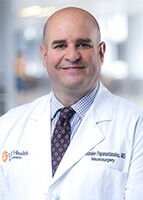Sitting in a diner, John Lattimore straightens his arm and hand. Both are steady. Five years ago, that was not the case.
Throughout his life, Lattimore has lived with essential tremors. The neurological condition he shares with his siblings includes shaking hands, arms, head, trunk and vocal cords. In 50%–70% of cases, it’s an inherited trait, according to the National Institute of Neurological Disorders and Stroke.
“Growing up, we would sit at the dinner table, and we were all constantly pounding it, and the table was shaking,” he said.
While serving in the military and throughout a 38-year nursing career, Lattimore could control the tremors and move forward with his life. Married for 54 years, a father and grandfather, the tremors did not disrupt his life until 2019.
“When I was working, I wasn’t aware of it, and the tremors were controlled,” he said. “But when I was home and focusing on it, it would be worse.”
After retiring and indulging in his favorite hobby of yard work and a new hobby, watercolor painting, he found he couldn’t hold gardening tools and paintbrushes steadily. His tremors were worsening.
“There were times when it was just so frustrating,” he said.
After meeting with Alexander Papanastassiou, MD, a UT Health San Antonio neurosurgeon, Lattimore chose to treat his tremors with deep brain stimulation surgery.

What is deep brain stimulation?
Deep brain stimulation, or DBS, is the placement of electrodes in the brain, specifically in the thalamus for essential tremor. The thalamus is an egg-shaped structure found in the middle of the brain near the brainstem. It acts as a relay station for movement and sensory information.
“We place the electrodes in the brain to stimulate the thalamus, and it has the effect of quieting it down and controlling the tremors,” said Papanastassiou. “It’s been the treatment of choice since the 1990s.”
According to Papanastassiou, the electrodes are connected through wires attached to a battery-powered generator in the chest wall. The advantage of DBS is that it’s reversible.
Deep brain stimulation at different targets is not only used for essential tremor but also for patients with Parkinson’s disease, epilepsy, obsessive-compulsive disorder and dystonia, according to the American Association of Neurological Surgeons.
With a .5% chance of permanent neurological deficit from a stroke or hemorrhage, Papanastassiou said the treatment is relatively safe. Infection is a risk of the surgery, and removing the device is required to treat the infection.
“Most patients who have an infection can’t wait to get it back in and don’t want to wait the three months it takes to be ready for re-implantation,” he said.
The surgery is typically 3–4 hours, and patients are traditionally awake. Lattimore said the idea of being awake during brain surgery gave him pause.
“I said no. But Dr. Papanastassiou said I had to be awake because he had to talk to me,” Lattimore said. “When they wheeled me into the surgical suite, I thought, what in the world is all that? I have never seen so many machines in a surgery suite.”
Papanastassiou said patients are awake during the surgery to ensure the correct brain area is stimulated. However, he and his team are acquiring advanced imaging protocols to allow the implantation of thalamic deep brain stimulation electrodes while the patient sleeps. Papanastassiou said the procedure is already available for other targets, including those used for Parkinson’s disease.
Today, Lattimore is grateful for the surgery.
“It changed everything. I couldn’t pick up a cup. Now, I can do all the little things I didn’t even think about,” he said.
Click here to learn more about DBS treatment.


